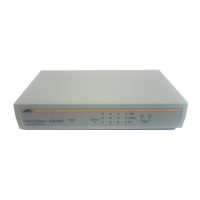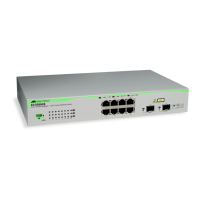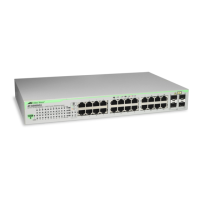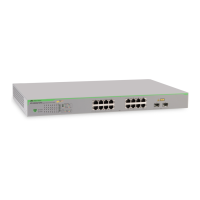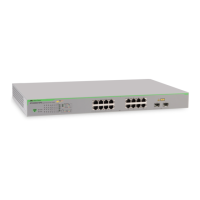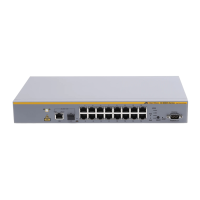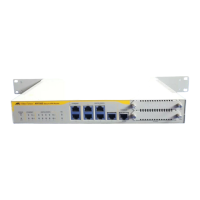Chapter 13 - QoS Commands
The AT-9724TS switch supports 802.1p priority queuing.The Switch has eight classes of service for each port on the Switch, one of which is internal and
unconfigurable to the user.These hardware classes of service are numbered from 6 (Class 6) – the highest hardware class of service – to 0 (Class 0) – the lowest
hardware class of service.The eight priority tags specified in IEEE 802.1p (p0 to p7) are mapped to the Switch’s hardware classes of service as follows:
• Priority 0 is assigned to the Switch’s Q2 class.
• Priority 1 is assigned to the Switch’s Q0 class.
• Priority 2 is assigned to the Switch’s Q1 class.
• Priority 3 is assigned to the Switch’s Q3 class.
• Priority 4 is assigned to the Switch’s Q4 class.
• Priority 5 is assigned to the Switch’s Q5 class.
• Priority 6 is assigned to the Switch’s Q6 class.
• Priority 7 is assigned to the Switch’s Q6 class.
Priority scheduling is implemented using two types of methods, strict priority and weight fair priority. If no changes are made to the QoS priority scheduling
settings the method used is strict priority.
Note: The Switch contains eight classes of service for each port on the Switch. One of these classes is reserved for internal use on the Switch
and is therefore unconfigurable.All references in the following section regarding classes of service will refer to only the seven classes of service that
may be used and configured by the Switch’s Administrator. (ex. port 21 of the SFP and port 21 of the 1000T), the SFP ports will take priority over the
combo ports and render the 1000T ports inoperable.
For strict priority-based scheduling, packets residing in the higher hardware classes of service are transmitted first. Only when these classes are empty, are
packets of lower hardware class allowed to be transmitted. Higher priority tagged packets always receive precedence regardless of the amount of lower priority
tagged packets in the buffer and regardless of the time elapsed since any lower priority tagged packets have been transmitted. By default, the Switch is configured
to empty the buffer using strict priority.
Note: The default QoS scheduling arrangement is a strict priority schedule.To customize scheduling to set up weight fair queue clearing, the
MAX. Packets values need to be changed using the config scheduling command. See config scheduling below.
To use implement weight fair priority, the Switch’s seven hardware classes of service can be configured to reduce the buffer in a weighted round-robin (WRR)
fashion - beginning with the highest hardware class of service, and proceeding to the lowest hardware class of service before returning to the highest hardware
class of service.
The weighted-priority based scheduling alleviates the main disadvantage of strict priority-based scheduling – in that lower priority classes of service get starved
of bandwidth – by providing a minimum bandwidth to all queues for transmission.This is accomplished by configuring the maximum number of packets allowed to
be transmitted from a given priority class of service before being allowed to transmit its accumulated packets.This establishes a Class of Service (CoS) for each
of the Switch’s seven hardware classes.
The possible range for maximum packets is: 0 to 15 packets.
The commands in the Command Line Interface (CLI) are listed (along with the appropriate parameters) in the following table.
Command Parameters
config bandwidth_control [<portlist> | all] {rx_rate [no_limit | <value 1-999>] | tx_rate [no_limit <value 1-999>]}
show bandwidth_control {<portlist>}
config scheduling <class_id 0-6> {max_packet <value 0-15>}
show scheduling
config 802.1p user_priority {<priority 0-7> <class_id 0-6>}
show 802.1p user_priority
config 802.1p default_priority [<portlist> | all] | <priority 0-7>
show 802.1p default_priority {<portlist>}
config scheduling_mechanism [strict | weight_fair]
show scheduling_mechanism
enable hol_prevention
disable hol_prevention
show hol_prevention
90
Allied Telesyn AT-9724TS High-Density Layer 3 Stackable Gigabit Ethernet Switch • Command Line Interface Reference Manual
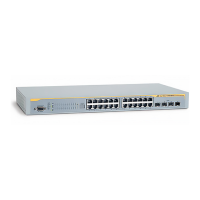
